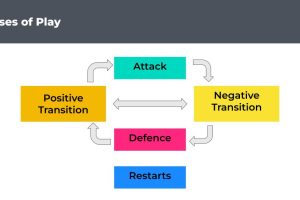The Role of Statistics in Soccer Strategy: How Data Analysis Shapes Winning Teams
Soccer, or football, is one of the most popular sports in the world, played and watched by millions of people. It is a complex game that requires players to make quick decisions and work together as a team to score goals and prevent the opposing team from doing the same. In recent years, the use of statistics in soccer strategy has become increasingly important, as coaches and analysts look for ways to gain an edge over their opponents.
Statistics can provide valuable insights into a team’s performance, as well as that of individual players. For example, by analyzing data on passing accuracy, shot placement, and other metrics, coaches can identify areas where their team needs to improve and develop strategies to address those weaknesses. They can also use statistics to evaluate the performance of individual players, identifying those who are most effective in certain positions or situations and adjusting their tactics accordingly.
Overall, the use of statistics in soccer strategy has become an essential tool for coaches and analysts looking to gain an edge over their opponents. By analyzing data on team and player performance, they can identify areas where their team needs to improve and develop effective strategies to address those weaknesses. As the sport continues to evolve, it is likely that the use of statistics will become even more important in shaping the way that teams play and compete.
The Importance of Statistics in Soccer
Statistics play a crucial role in soccer strategy. By analyzing player performance and tactics, coaches and analysts can gain valuable insights into their team’s strengths and weaknesses, as well as those of their opponents. This information can then be used to inform game plans, substitutions, and other strategic decisions.
Player Performance Analysis
One key area where statistics are used in soccer is in player performance analysis. By tracking metrics such as goals scored, assists, and pass completion rates, coaches can identify which players are performing well and which ones may need more support or training. Additionally, data on defensive actions such as tackles, interceptions, and clearances can help coaches evaluate the effectiveness of their team’s defensive strategy.
Advanced statistics can also provide more nuanced insights into player performance. For example, Expected Goals (xG) is a metric that uses data on shot location and other factors to estimate the likelihood of a shot resulting in a goal. By comparing a player’s actual goals scored to their xG, coaches can identify players who may be underperforming or overperforming relative to their expected output.
Tactical Analysis
Statistics can also be used to analyze team tactics and strategy. By tracking metrics such as possession percentage, pass completion rates, and shots on target, coaches can gain a better understanding of their team’s playing style and identify areas for improvement. Additionally, data on opponent tactics and performance can be used to inform game plans and make strategic adjustments during matches.
One key area where tactical analysis is used is in set piece strategy. By analyzing data on opponent defending and player positioning, coaches can design set piece plays that are more likely to result in goals. Similarly, data on opponent attacking patterns can be used to design defensive strategies that are more effective at preventing goals.
| Metric | Description |
|---|---|
| Goals Scored | The number of goals a player has scored in a given time period |
| Assists | The number of goals a player has assisted on in a given time period |
| Pass Completion Rate | The percentage of a player’s passes that are completed successfully |
| Tackles | The number of times a player has successfully tackled an opponent |
Overall, statistics are an essential tool for soccer coaches and analysts. By providing insights into player performance and tactics, they can help teams make more informed strategic decisions and gain a competitive edge on the field.
Data Collection and Analysis
Data collection and analysis are essential components of modern soccer strategy. Teams use a variety of data sources, including video footage, GPS tracking, and wearable technology, to collect data on player performance and team tactics. This data is then analyzed using statistical tools to identify patterns and trends that can inform game strategy and player development.
Types of Data Collected
There are many types of data that soccer teams collect to inform their strategy. Some of the most common types of data include:
- Player performance data, including speed, distance covered, and heart rate
- Passing and shooting data, including the number of passes completed, shots taken, and goals scored
- Positional data, including the location and movement of players on the field
- Opponent data, including the strengths and weaknesses of opposing teams and players
By collecting and analyzing this data, teams can gain a better understanding of their own strengths and weaknesses, as well as those of their opponents. This information can be used to develop more effective game strategies, make better player recruitment decisions, and improve player training programs.
Statistical Analysis Tools
There are many statistical analysis tools that soccer teams can use to analyze their data. Some of the most commonly used tools include:
| Tool | Description |
|---|---|
| Regression analysis | A statistical method used to identify relationships between variables |
| Cluster analysis | A statistical method used to group similar data points together |
| Decision trees | A statistical method used to identify the most important variables in a dataset |
These tools can be used to identify patterns and trends in the data, as well as to develop predictive models that can inform game strategy and player development. By using these tools, teams can gain a competitive edge and improve their chances of success on the field.
Applications of Statistics in Soccer Strategy
Player Recruitment
Statistics play a significant role in player recruitment. Clubs use data analytics to evaluate potential players and make informed decisions. The data collected includes players’ physical attributes, technical skills, and psychological characteristics. Clubs use this data to identify players who fit their style of play and to find players who can fill specific roles in the team.
For example, data analytics can help identify players who are good at creating goal-scoring opportunities, players who can score from set-pieces, or players who have exceptional ball control skills. Clubs can also use data analytics to evaluate a player’s injury history and performance in previous seasons to determine if they are worth the investment.
Match Analysis
Statistics are also used to analyze matches and develop game strategies. Clubs use data analytics to evaluate their own performance and the performance of their opponents. They use this data to identify areas where they need to improve and to develop strategies to exploit their opponents’ weaknesses.
For instance, data analytics can help identify the most effective attacking patterns, the most effective defensive strategies, and the most effective ways to create goal-scoring opportunities. Clubs can also use data analytics to evaluate the performance of individual players and to identify areas where they need to improve.
Training and Conditioning
Statistics are also used to develop training and conditioning programs. Clubs use data analytics to evaluate the physical performance of their players and to identify areas where they need to improve. They use this data to develop customized training programs that focus on improving specific physical attributes.
For example, data analytics can help identify players who are at risk of injury and develop injury prevention programs. Clubs can also use data analytics to evaluate the effectiveness of their training programs and adjust them accordingly.
Limitations of Statistics in Soccer
While statistics can be a valuable tool in soccer strategy, there are also limitations to their use. One limitation is that statistics can only tell part of the story. Soccer is a complex game with many variables that cannot always be quantified. For example, a player’s work rate off the ball or their ability to make runs that open up space for teammates may not be reflected in the statistics.
Another limitation is that statistics can be misleading. A team may dominate possession and have more shots on goal, but still lose the game due to a single mistake or a moment of brilliance from the opposition. In this case, the statistics may suggest that the losing team played better, when in fact they were unable to capitalize on their dominance.
Furthermore, statistics can be affected by the context in which they are collected. For example, a team may have a high number of successful tackles, but this may be due to their opponents playing a more direct style of soccer that involves fewer passes and more long balls. In this case, the statistics may not accurately reflect the team’s defensive ability.
Finally, statistics can be manipulated to support a particular narrative or agenda. For example, a team may choose to focus on a particular statistic, such as possession, to suggest that they are the better team, even if they are not creating many scoring opportunities or winning games.
| Limitation | Explanation |
|---|---|
| Partial Story | Statistics cannot quantify all aspects of the game. |
| Misleading | Statistics may not reflect the outcome of the game. |
| Context-dependent | Statistics can be affected by the context in which they are collected. |
| Manipulation | Statistics can be manipulated to support a particular narrative or agenda. |





